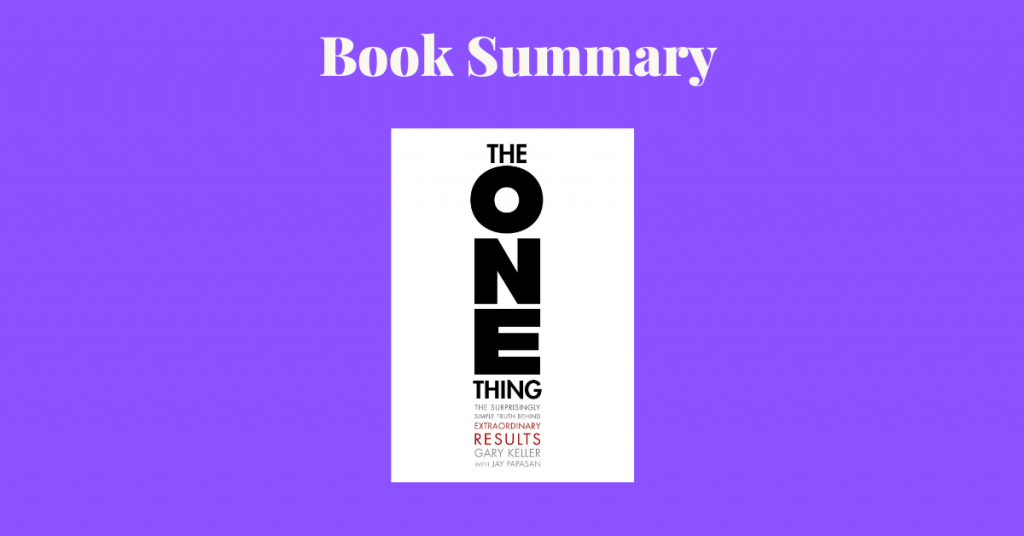The ONE Thing by Gary Keller and Jay Papasan is a self-help book that focuses on the importance of focusing on one goal at a time.
The book focuses on a few essential concepts, such as prioritization, creating goals, and the effectiveness of single-tasking over multitasking, among other things.
One of the most important lessons that they teach is that the greatest place to focus is on the one thing that, by putting your attention on it, will make areas in your life either easier or irrelevant.
The ONE Thing’s ideas and teachings, when applied, will help you achieve tremendous development in all areas of your life, including your work career, your personal life, your relationships, and your spiritual life.
Book Title: The ONE Thing: The Surprisingly Simple Truth Behind Extraordinary Results
Author: Gary Keller, Jay Papasan
Date of Reading: June 2022
Rating: 8/10
What Is Being Said In Detail
One Thing by Gary Keller and Jay Papasan is an excellent book on how to get more done in less time by following a simple premise: you can’t get more done if you don’t get less done.
The book has three parts and 18 chapters.
The first section discusses the five lies that prevent us from achieving success. Lies like multitasking, a disciplined lifestyle, an opinion on work-life balance, and willpower are just a few of the myths that have been debunked. These lies are explained in great detail by the authors, allowing readers to have a better understanding of them.
The second section is the most important since it provides a practical framework to follow in order to be highly productive. This chapter shows us how to use the focusing question in our daily lives so that we can finish our tasks more efficiently.
The third part is about making sure your thoughts match your dedication, purpose, and priorities so you can get great results.
In summarizing, the content is well-written and well-organized with quotes and statistics, and it helps us be more productive by explaining the key concepts on which successful people rely.
The ONE Thing
Chapter 1 argues that if you want to have the best chance of succeeding at anything, you should always take the same approach: keep it small.
This can be accomplished by understanding that amazing results are directly proportional to how narrow your focus can be adjusted. To achieve meaningful goals, we must prioritize.
The Domino Effect
Chapter 2 explains that achieving extraordinary results requires a domino effect. The goal is to identify the most significant focal point in every aspect of your life.
After identifying the objective, determine the “dominoes” that must be set up and knocked down. Remember to start small. Success is created progressively and over time.
Success Leaves Clues
Chapter 3 explains how every person has one area of expertise or interest that they thrive in. Even if you’re terrible at other things, you’ll always have a unique skill that sets you apart from the rest. We are all good at something, and the goal is to discover what it is.
Everything Matters Equally
Chapter 4 discusses the importance of prioritization and the Pareto Principle. This principle urges us to prioritize our tasks and goals. Those 20% that areas are responsible for 80% of the results.
After that, we take those 20% and cut them down even more, until you’re left with just one “domino” to focus on.
Multitasking
Chapter 5 debunks a second myth: that multitasking is beneficial. We cannot do two things at the same time because it naturally distracts us, yet multitasking involves moving back and forth between incomplete tasks, which eventually results in a loss of time and productivity.
Myth: A Disciplined life
Chapter 6 describes the third lie he’s encountered: discipline is all you need to succeed. Discipline implies consistently doing something until it becomes a habit or routine.
It’s all about teaching your mind to perform things until they become automatic. To achieve that, create habits one at a time.
Willpower is Always on Will-Call
Chapter 7 focuses on the fourth lie, which is that willpower is always present and accessible. Instead, he explains that willpower is like a battery, and it will ultimately run out.
In that instance, willpower should be controlled to complete the most crucial and challenging work while also recognizing when it has been drained.
You can’t give up your willpower for things that aren’t important. Willpower also requires you to be at your best, so eat well and don’t let anything slip.
Myth: A Balanced Life
Chapter 8 discusses the fifth lie, which is the concept of having a “balanced life.” This results in an issue with productivity because when we try to strike a balance, we tend to find a middle ground in which we give equal attention to everything.
This means that we can only provide a minimal level of input in those areas, which will lead to average results. Instead, we should focus our efforts on the most important aspects of our lives.
Myth: Big is Bad
In Chapter 9, the sixth lie he analyzes is that “big is bad.” When we are hesitant to dream “large,” we lose sight of our genuine limits, restricting our potential.
When deciding what to accomplish next, set your sights higher and bigger because doing so will allow you to surpass your original goal. Don’t limit yourself to the possibilities that are readily available to you.
However, if you want to succeed, you must be daring and quit being afraid of failure because amazing outcomes are based on failures as well as achievements.
The Focusing Question
Chapter 10 discusses how, in order to achieve something remarkable, we must ask questions along the road, because excellent questions lead to equally incredible solutions.
Questioning will help you find the first domino to success. The question you ask is known as a “focusing question,” and it is made up of two parts: the “big picture” question and the “small-focus” question.
The first helps you in creating a vision for your life and moving forward in the right way, while the second helps you focus on what is most valuable to you.
The Success Habit
Chapter 11 explains that in order to make that ONE item a part of your habit, the very first step is to accept it after comprehending it.
It’s also necessary to ask the focusing question at every chance to make things simpler. If you ask yourself these kinds of questions on a frequent basis, it will become ingrained in your mind.
Remember to keep doing it no matter how long it takes. To ensure that you don’t lose track of the key question, you may put up a few reminders.
Finally, surround yourself with people who have a positive influence on your life.
The Path to Great Answers
Chapter 12 explains the three types of responses to the focused question: achievable, stretchable, and possible.
For the best results, you must accept the fact that your answer will be beyond your comfort zone. Setting yourself a goal is another way to think about a good focus question.
Be aware that an easy goal may just be a way to check something off your list, while a hard goal may push you to grow beyond what you can do now.
Live With Purpose
Chapter 13 explains how to be happy, you must have a purpose for your life. Our goals may differ, but when you ask yourself what motivates you every day, the answer is easy to spot.
In the book, the writers refer to this question as the “Big Why,” and it explains why you’re doing the things you are. To get things done, you don’t need a complicated or weighty stated purpose; all you need is a single motivating factor.
Live By Priority
Chapter 14 examines goals and priorities. When you have a goal in mind, you have a better idea of what needs to be done and how to go about accomplishing it.
You make ONE thing your priority. Even if you have a lot on your plate any given day, it’s always a good idea to check in with yourself and figure out what your top priorities are. In addition, you may define future objectives with priority and find the most significant goal.
Live for Productivity
Chapter 15 explains that it’s easy to know what you want to do if you have a clear goal and set priorities to help you achieve that goal.
Everything else is a matter of getting started and completing the task at hand. Analyzing your ideas continually is the greatest way to get the ONE thing to work for you.
The Three Commitments
Chapter 16 emphasizes the importance of narrowing your focus and working hard to become an expert in one specialized area.
If your goal is to be the best at something that really matters to you, then you’re already on the right track.
For this reason, you should start out to achieve mastery with a specific goal in mind, because achieving mastery without a specific goal can limit your ability to think creatively and open yourself up to new opportunities and beginnings.
Even if you succeed or fail, you must take full responsibility for your actions.
The Four Thieves
Chapter 17 highlights the importance of productivity. However, the four robbers that threaten to steal our productivity are all around us:
The inability to say “no” – If you’re continually being asked to do something that takes you away from your ONE thing, you should be able to say “no.” The more you say yes, the less productive you’ll be since you’re giving up something else in the process.
Fear of chaos – Pursuing your ONE thing might cause inevitable chaos because you’re ignoring everything else but your main goal. But if you achieve your main goal, you should be able to deal with these smaller problems.
A lack of vitality or poor health – Don’t put yourself in a position of stress by taking on too much. If you don’t take care of your body, it will affect your health, which is vital to achieving your goals.
The wrong people – Make sure you associate yourself with individuals who are supportive of your goals.
The Journey
Chapter 18 concludes by stating that in order to live a great life, your dreams must be converted into actions.
The author instructs us to write on a piece of paper your salary and multiply it by whatever number you like, such as 2, 3, or 4. Ask yourself if your present lifestyle and actions can help you meet your goal in the next five years.
If yes, multiply that amount till it doesn’t match; if it does, you’ve lived large! However, you may also use this in other aspects of your life besides money. It’s important to stick with just one thing and keep going until you’ve accomplished it.
Most Important Keywords, Sentences, Quotes
CHAPTER ONE – The ONE Thing
“When you want the absolute best chance to succeed at anything you want, your approach should always be the same. Go small.”
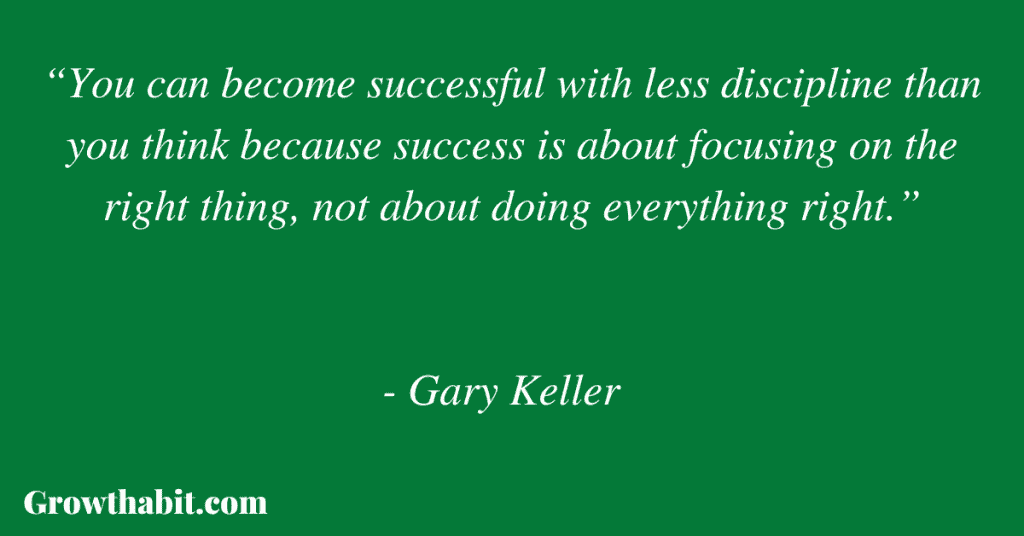
“Going small” is ignoring all the things you could do and doing what you should do. It’s recognizing that not all things matter equally and finding the things that matter most.
It’s a tighter way to connect what you do with what you want. It’s realizing that extraordinary results are directly determined by how narrow you can make your focus.”
“[…] big success comes when we do a few things well.”
CHAPTER TWO – The Domino Effect
“Highly successful people know they must line up their priorities. They find the lead domino and whack away at it until it falls.”
“Extraordinary success is sequential, not simultaneous. Success builds on success.”
“[…] find the lead domino, and whack away at it until it falls.”
“The key to success is built over time. It is built sequentially. It’s one thing at a time.”
CHAPTER THREE – Success Leaves Clues
“We each have passions and skills, but you’ll see extraordinarily successful people with one intense emotion or one learned ability that shines through, defining them or driving them more than anything else.”
“Passion for something leads to disproportionate time practicing or working at it. That time spent eventually translates to skill, and when skill improves, results improve. Better results generally lead to more enjoyment, and more passion and more time is invested.”
CHAPTER FOUR – Everything Matters Equally
“THE SIX LIES BETWEEN YOU AND SUCCESS
- Everything Matters Equally
- Multitasking
- A Disciplined Life
- Willpower Is Always on Will-Call
- A Balanced Life
- Big Is Bad”
“A to-do list is simply the things you think you need to do; the first thing on your list is just the first thing you thought of. To-do lists inherently lack the intent of success. ”
“Pareto points us in a very clear direction: the majority of what you want will come from the minority of what you do. Extraordinary results are disproportionately created by fewer actions than most realize.”
“Don’t stop at the 80/20 Principle. Take 20% of the 20% of the 20% and continue until you get to the single most important thing.”
CHAPTER FIVE – Multitasking
“The truth is multitasking is neither efficient nor effective. In the world of results, it will fail you every time.”
“Multitasking takes a toll. Distractions lead to poor choices, painful mistakes, and unnecessary stress.”
“In order to be able to put the principle of The ONE Thing to work, you can’t buy into the lie that trying to do two things at once is a good idea.”
CHAPTER SIX – Myth: A Disciplined life
“Success is not a marathon of disciplined action.”
“Success is actually a short race – a sprint fueled by discipline just long enough for habit to kick in and take over.”
“You can become successful with less discipline than you think because success is about focusing on the right thing, not about doing everything right.”
“Your life gets clearer and less complicated because you know what you have to do well and you know what you don’t.”
“Super successful people aren’t superhuman at all; they’ve just used selected discipline to develop a few significant habits. One at a time. Over time.”
CHAPTER SEVEN – Willpower is Always on Will-Call
Willpower isn’t on will-call. Let’s face it we don’t always have willpower. It comes and goes.
“[…] willpower or the ability to delay gratification is a huge indicator of future success.
“Willpower has a limited battery life but can be recharged with some downtime. It’s a limited but renewable resource.”
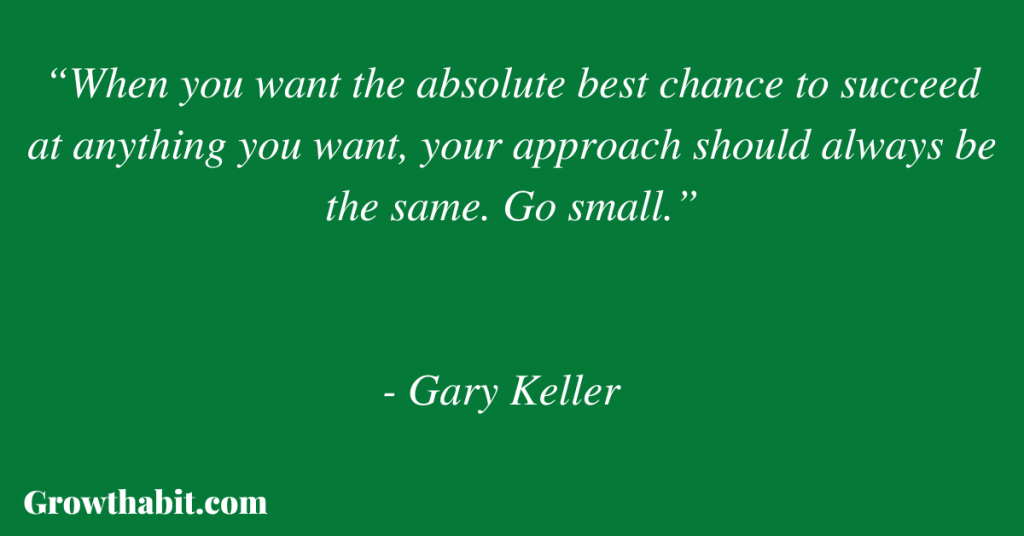
“Because you have a limited supply, each act of will creates a win-lose scenario where winning in an immediate situation through willpower makes you more likely to lose later because you have less of it.”
“Without intentionally protecting our willpower every day, we allow ourselves to go from a will and a way, to no will and no way. If success is what we’re after, this won’t work.”
“When your willpower is at its highest, you do what matters most. Do your most important work – your ONE Thing – early, before your willpower is drawn down.”
CHAPTER EIGHT – Myth: A Balanced Life
“Purpose, meaning, significance – these are what make a successful life. Seek them and you will most certainly live your life out of balance.”
“Extraordinary results require focused attention and time. Time on one thing means time away from another. This makes balance impossible.”
“The idea of counterbalancing is that you never go so far that you can’t find your way back.”
“In your personal world, awareness of your spirit and body, awareness of your family and friends, awareness of your personal needs, none of these can be sacrificed if you intend to “have a life.” Your personal life requires tight counterbalancing.”
CHAPTER NINE – Myth: Big is Bad
“It’s quite possibly the worst lie of all, for if you fear big success, you’ll either avoid it or sabotage your efforts to achieve it.”
“Believing in big frees you to ask different questions, follow different paths, and try new things. This opens the doors to possibilities that until now only lived inside you.”
“Act boldly. Big thoughts go nowhere without bold action.”
“Don’t be afraid to fail. See it as a part of your learning process and keep striving for your true potential.”
CHAPTER TEN – The Focusing Question
“To get answers we seek, we have to invent the right questions.”
“[…] you ask one question: the Focusing Question.”
“The Focusing Question asks you to find the first domino and focus on it exclusively until you knock it over.”
CHAPTER ELEVEN – The Success Habit
“The Focusing Question is the foundational habit to achieve extraordinary results and to lead a big life. Apply it to the important areas of your life:
Spiritual life
Physical health
Personal life
Key relationships
Professional life
Financial life”
CHAPTER TWELVE – The Path to Great Answers
“The challenge of asking a Great Question is that, once you’ve asked it, you’re now faced with finding a Great Answer.”
“If you want the most from your answer, you must realize it lives outside your comfort zone.”
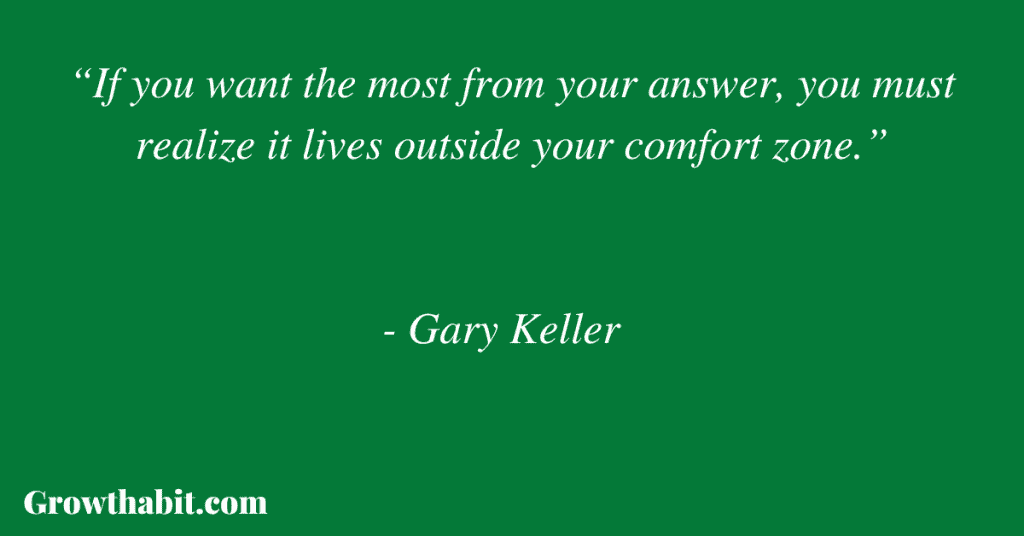
“[…] the best goal explores what’s possible. This is where high achievers that have undergone transformation, this is where they live.”
CHAPTER THIRTEEN – Live With Purpose
“Our purpose sets our priority and our priority determines the productivity our actions produce.”
“The prescription for extraordinary results is knowing what matters to you and taking daily doses of actions in alignment with it.”
“The surest path to achieving lasting happiness happens when you make your life about something bigger, when you bring meaning and purpose to your everyday actions.”
“Discover your Big Why? What’s the thing that gets you up in the morning and keeps you going when you’re tired and worn down?”
CHAPTER FOURTEEN – Live By Priority
“Live with purpose and you know where you want to go. Live by priority and you’ll know what to do to get there.”
“Purpose without priority is powerless.”
“Your most important priority is the ONE Thing you can do right now that will help you achieve what matters most to you.”
CHAPTER FIFTEEN – Live for Productivity
“Putting together a life of extraordinary results simply comes down to getting the most out of what you do. Living for productivity produces extraordinary results.”
“By planning your time off in advance, you are managing your work time around your downtime instead of the other way around.”
“The most productive people work on event time, i.e., they don’t quit until their ONE Thing is done.”
CHAPTER SIXTEEN – The Three Commitments
“Achieving extraordinary results through time blocking requires three commitments:
You must adopt the mindset of someone seeking mastery.
You must continually seek the very best ways of doing things.
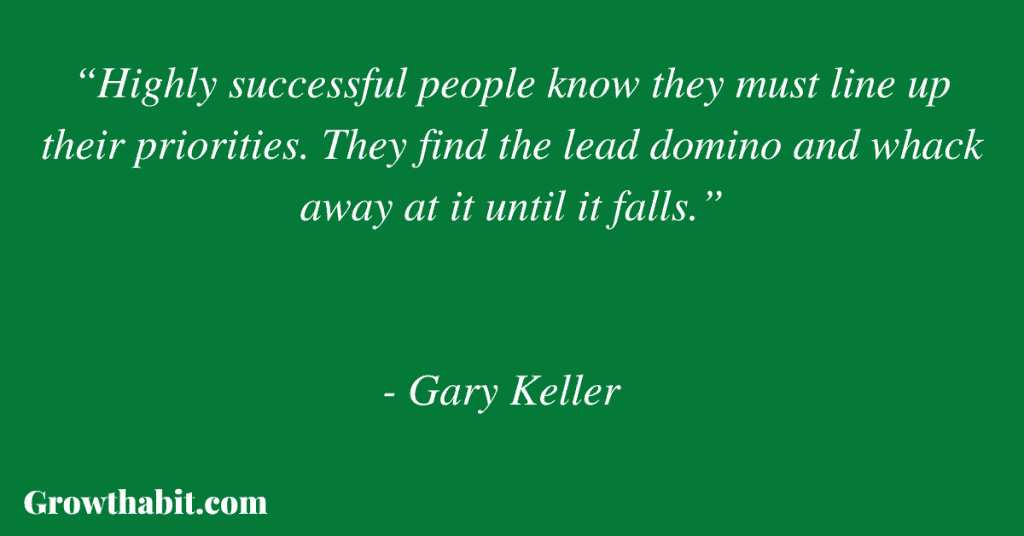
You must be willing to be held accountable to doing everything you can to achieve your ONE Thing.”
“Continually improving how you do something is critical to getting the most from time blocking.”
“Accountable people achieve results others only dream of.”
“One of the fastest ways to bring accountability to your life is to find an accountability partner.”
CHAPTER SEVENTEEN – The Four Thieves
“The way to protect what you’ve said yes to and stay productive is to say no to anyone or anything that could derail you.”
“When you strive for greatness, chaos is guaranteed to show up. It’s important for you to accept this instead of fighting it.”
“Personal mismanagement is a silent thief of productivity. Don’t sacrifice your health by trying to take on too much.”
“High achievement and extraordinary results require big energy.”
“Make sure your physical surroundings support your goals.”
CHAPTER EIGHTEEN – The Journey
A life worth living is a life of no regrets.
When people look back on their lives, it is the things they have not done that generate the greatest regret.
All success starts within you. You know what to do. You know how to do it.
Book Review (Personal Opinion):
This is an extremely well-illustrated and simple-to-follow book. This book helps readers discover the answers to the most pressing concerns about their personal lives, families, careers, and work-life balance.
This is an excellent resource for learning how to be more efficient with your time and get more done. It’s the book’s major goal to demonstrate that people aren’t capable of multitasking. Multitasking is not a natural ability for humans. Their ability to focus on one thing at a time is limited and requires a lot of time and effort.
If you want the best results possible, do one thing at a time and use only 20% of your efforts to get 80% of the results. Set yourself high-level, complex assignments and learn to say “NO” to tasks that do not fit your “one thing.” The book contains numerous interesting quotations, anecdotes, and examples.
I gave this book an 8 out of 10, since several of the chapters near the middle appeared to be page fillers. But overall, I highly recommend this book.
Rating: 8/10
This Book Is For:
- Anybody who appears to have an excessive amount of work to accomplish.
- A person trying to do too much at once.
- Anyone who is interested in improving their productivity and making progress toward their goals.
If You Want To Learn More
Here is an interview that Kevin Kauffmann held with Gary Keller in which he presents generally The One Thing and his main inspirations for writing the book. Gary Keller talks about the One Thing. Interview with Kevin Kauffman
How I’ve Implemented The Ideas From The Book
Gary Keller teach the readers about the significance of introspection, the Pareto principle of prioritization, engaging in work that one is passionate about, and accepting full responsibility for one’s actions.
All of these are aspects of my life that I have been focusing my attention on improving for a considerable amount of time. The focusing question let me see things more clearly.
You can use his “focused question” in any situation and then use the results of that exercise to ask another “focused question,” and so on, until you get to the “lead domino” of what you should do next to move you closer to what you want.
One Small Actionable Step You Can Do
The book teaches you how to ground your projects (or ideas of things you would like to achieve), from the initial idea to having very specific daily tasks.
For me, the most important thing is to start with the Pareto Principle and to really focus on that one thing that would make you go forward. And from there, you set goals for 1 day, t week, 1 month, 5 years or even up to 10 years.
In this way, you are taking small steps to achieve that great goal you want to achieve.
